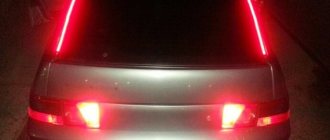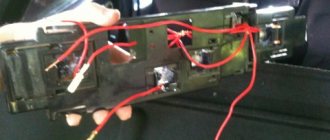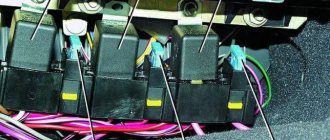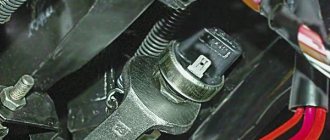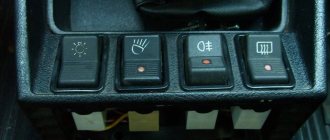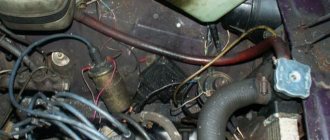On all cars of the Tenth Family, the power lines for the lights contain many elements. There are lamp health relays, switches and fuses. Therefore, if the brake lights on a VAZ-2112 do not light up, you need to check the entire chain.
But the reason may look simple: sometimes the lamps do not turn on because the socket does not contact ground. Circuits are easy to analyze, but finding the cause of a breakdown is difficult. Let's look into the details.
[custom_ads_shortcode1]
If the lamps do not light, it is simply replaced.
Why do the brake lights on the VAZ-2112 not light up or work, what should I do?
On all cars of the Tenth Family, the power lines for the lights contain many elements. There are lamp health relays, switches and fuses. Therefore, if the brake lights on a VAZ-2112 do not light up, you need to check the entire chain. But the reason may look simple: sometimes the lamps do not turn on because the socket does not contact ground. Circuits are easy to analyze, but finding the cause of a breakdown is difficult. Let's look into the details.
If one of the lamps does not light, it is simply replaced. See the example in the video - you need a P21 W
Injection "ten"
In addition to the wiring that is provided for the VAZ 2110 - carburetor, "ten" - injector, it is also equipped with a number of fuses that protect almost all of it from the possibility of short circuiting.
Structurally, fuses are not provided only for the electrical supply via a relay wire from the battery, in the car starting and ignition circuit, as well as for the wire going to the generator.
Electrical circuit of an injection car
In addition, the injector (as opposed to the carburetor) is a more complex system, and in order to repair it yourself, you need to understand it well. The controller in this wiring system “reads” the operation of all systems, thereby determining and setting many indicators - calculation of the fuel mixture, etc.
Standard version of the brake light operating diagram
Power is supplied to fuse F17 from the battery, then the current goes to limit switch contact 11, and then, if the limit switch is closed, a circuit is formed with the filament of lamps 7. But note: part of the circuit is relay K1, more precisely, its contacts 5 and 4.
If the brake lights do not light up, on the VAZ-2112, as on all Tens, check one fuse. It is called F17 and is located in the mounting block to the left of the driver.
It is important to know: voltage is always present at one of the fuse terminals. Check it out!
A few words about the “serviceability relay”
The lamp health relay is called K1, and it is the largest in the mounting block. If you remove this relay, then when you press the pedal you can dial the voltage at terminal 5 (but not 4). Look at the diagram again, and it will become clear what we are talking about.
The largest relay in the block
All relay contacts are numbered. Check the voltage at the block terminals:
- 6 – “mass” potential;
- 2 – voltage “+12”, but only after turning on the ignition;
- 5 – “+12” by pressing the pedal;
- 4 – the terminal rings like a ground tap.
If the potential “0” is not generated at terminal “4,” it means that the lamp filaments are burnt out or there is a break in the wiring. Now consider something else: the ground potential has been detected, but the lamps do not light. This is where suspicions of a short circuit arise.
LED lamps - why they are better
Many foreign cars these days are equipped with LED lamps instead of the usual incandescent lamps. Such lamps are installed in rear lights as brake lights, side lights, and turn indicators. This is no coincidence. This light gives the driver behind him additional time to make decisions and make maneuvers. Advantages of LED lamps:
- longer service life, higher light output;
- The LED lights up many times faster than a conventional lamp. This is an additional 5-6 m at a speed of 100 km/h.
- Incandescent lamps fail earlier most often due to strong vibration, especially considering the quality of Russian roads. In terms of this indicator, LEDs are much more durable and vibration is not a problem for them.
We turn on the brake lights forcibly
Relay K1 is successfully replaced with a pad with jumpers. In Fig. 1 just shows its diagram. If there is no such platform, you can temporarily close contacts 4-5. First, check everything mentioned above.
Have an observer watch what happens to the lamps. Press the pedal with one touch and release it. If the lamps do not turn on, check that the fuse is working properly. It's burned out, which means you're looking for a short circuit.
How to and how not to check the “0 Volt” potential
Let’s agree right away that we only work with a voltmeter. Voltage “+12” is caused by connecting one probe to ground. The presence of potential “zero” is checked differently: any of the probes is connected to a terminal with positive voltage, and then the second probe is connected to the wire being tested.
Consider the error: one probe is connected to ground, the second to the terminal being tested, and vol. Here they conclude that there is a “mass” potential, but this is wrong! If the contact with ground is broken, the device will also show “0”. That is, the number “0” does not contain information.
Installing a block for automatic engine start
The device is assembled. The wires are signed. I also insulated everything and signed all the wires. I like order in everything, and I advise you to do the same.
In the car, I first removed one terminal from the battery so as not to get hurt myself and only then got into the wiring.
I connected the wires of our device to the engine starting system block. First, I took out the car alarm unit and identified the wires from the additional channels, and also figured out the sensors and door locks. I have a blue wire going to the handbrake. I didn’t capture the process itself on camera, but I think everything is clear here.
As a result, everything is connected perfectly for me.
I only have one green wire left free. You can stick it anywhere. I even thought about putting it on the radio. I imagined how I find my car in the dark by the sounds of my favorite radio wave - I smiled. Otherwise, it can be placed on headlights or side lights - it’s more convenient to look for. I haven't decided yet.
Having removed the steering casing, I hid the remote start unit there - it fit! That's the whole installation!
Using autorun in practice
I launched it from home. Here's my procedure:
- Disarmed.
- I start the fuel pump - this is my first additional channel. Be careful not to get confused!
- I block the doors.
- I'm starting the starter. The first time I didn't have enough 3 seconds for the engine to start, so I pressed the button twice.
- The engine started up and began to purr, making me happy.
- I go to the car and remove the lock from the key fob.
- I get into the car, insert the key into the ignition, turn it one notch.
- I take the handbrake off and listen to my car stall (the car thieves won’t be able to get away - it’s a trick).
- You can go.
If you change your mind or decide to reschedule the trip, go to the car, take the handbrake off and turn it off. (Although, as an option, you can install an additional relay for this purpose - a simple matter).
So, I have outlined everything, I hope it is accessible and understandable. This is my first master class, so I accept all comments, take into account wishes, and accept praise!
Didn't find the information you are looking for? on our forum.
We recommend reading:
Gasoline consumption of Lada Kalina per 100 km, average figures
VAZ 2112 16 valves technical specifications
Poor charging on a VAZ 2109 carburetor, reasons, how to fix it
What kind of oil to fill in VAZ 2115
Adjusting the carburetor on a VAZ 2106
How to adjust the clutch on a VAZ 2106
Lada Largus which gasoline to fill 92 or 95, manufacturer's recommendations
How to connect an ESP to a VAZ 2110
Wiring test for non-working brake lights (ground test)
Let's look at the basic diagram: the brake lights and the reversing lamps have a common ground pin. If contact with this pin is broken, the reverse lamps will not turn on. Well, brake lights too.
Connector for connecting “internal” lights
On the left side there is a connector through which the wiring goes to the fifth door. The connector has black and red wires. Check the voltages on them. Most often the ground on the black wire does not ring. But maybe the connector itself needs to be cleaned.
Usually, if the ground breaks, another pin is used - the one that is connected to the glass heating coil.
If the “plus” does not come to the red wire, we check the “frog”. It's simple here:
- Disconnect the connector with two wires from the limit switch;
- Using 17mm wrenches, loosen the two nuts: holding the lower nut, rotate the upper one;
By the way, one of the connector terminals receives a voltage of “12 Volts”. Check it!
If all the steps do not lead to results, there is only one thing left: contact a qualified electrician. We wish you success.
Source
Design of the rear light of the VAZ 2110
Bulbs in the taillights of the VAZ 2110
The rear light of the car consists of the following sections:
- anti-fog light (red light diffuser);
- reversing lights (white light diffuser);
- turn indicator (orange light diffuser);
- side light and brake signal (red light diffuser);
- reflector (reflector).
Brake lights do not work on VAZ 2112
The VAZ-2112 passenger car can be equipped with three brake lights, two of which are located in the right and left rear lights, and the third, which is additional, is on the spoiler. You cannot drive onto the road with brake lights that are not working, because they are the ones who warn drivers behind moving vehicles about your braking, which allows you to avoid a rear-end collision with your car.
There are two options for the brake lights not working, either the light in one of them does not light up, or all the lights in these lights do not light up. In the first case, the driver will have to check the condition of the brake light lamp to see if its tungsten filament has burned out. If the filament burns out, then replace it with a new light bulb of similar power. And if the light bulb is intact, then we clean the contacts in its socket and slightly pull out the central contact.
In the second case, it will take much longer to find the fault, since the likelihood of all three lamps burning out at the same time is unlikely. First, we check the condition of the fuse that protects this electrical circuit. This can be done very quickly, just turn on the interior lighting. If there is light, then fuse F17 (7.5A) is safe and sound, since it also protects this electrical circuit, and if there is no light, then you will have to open the mounting block and make sure that the fuse has blown.
Considering that the brake lights are located in the rear door, this means that the wiring harness going to them will bend if this door is opened or closed, which over time can lead to wire breaks. To check this assumption, you need to find the connector, which is located on the right behind the interior trim. You will have to disconnect it and use a tester to check the connector, which is popularly called “male,” for a short circuit. You will be interested in two wires: red (+ for brake lights) and black, it goes to ground.
If there is no tester, then you can check the condition of these two wires in another way. To do this, you will need two long wires to connect the positive terminal of the battery to the connector contact where the red wire goes, and the negative terminal of the battery to the contact with the black wire. If it turns out that the brake light lamps do not light up, then you will have to dismantle this wiring harness and then fix the problem. Well, if it turns out that the brake light lamps are on, then you will have to use a tester to check the wires of this female connector to the mounting block block. Also, a possible malfunction may be the brake light switch located above the brake pedal.
Source
Causes of malfunction
The main reasons for this malfunction are:
- defective or burnt out light bulb;
- break in electrical wiring or plug connections;
- fuse blown due to a short circuit or overload in the on-board network;
- limit switch malfunction;
- problems with electronic systems or units.
Such malfunctions can usually occur on high-mileage vehicles. However, there are exceptions.
The brake lights on the VAZ-2112 do not light up or work, why?
On all cars of the Tenth Family, the power lines for the lights contain many elements. There are lamp health relays, switches and fuses. Therefore, if the brake lights on a VAZ-2112 do not light up, you need to check the entire chain.
But the reason may look simple: sometimes the lamps do not turn on because the socket does not contact ground. Circuits are easy to analyze, but finding the cause of a breakdown is difficult. Let's look into the details.
If the lamps do not light, it is simply replaced.
Replacing a headlight bulb - how it is done
Light bulb for rear light of VAZ 2110
To change the headlight bulb in the headlight, you need to perform the following steps:
- remove the battery;
- holding the lamp from behind, separate the wires in the block directly from the lamp;
- remove the rubber cover;
- remove the end of the spring retainer with the hook from engagement, move the retainer to the side;
- remove the light bulb from the headlight housing;
- install a new lamp, performing the reverse sequence of actions.
Note. If the side light bulb in the headlight turns out to be faulty, it must be replaced on site. Otherwise, you need to drive to where the repairs will be carried out with the headlight lamp turned off.
Standard version of the brake light operating diagram
Power is supplied to fuse F17 from the battery, then the current goes to limit switch contact 11, and then, if the limit switch is closed, a circuit is formed with the filament of lamps 7. But note: part of the circuit is relay K1, more precisely, its contacts 5 and 4.
If the brake lights do not light up, on the VAZ-2112, as on all Tens, check one fuse. It is called F17 and is located in the mounting block to the left of the driver.
It is important to know: voltage is always present at one of the fuse terminals. Check it out!
Basic adjustment aspects
In order for the light to illuminate the road efficiently and not blind oncoming drivers, you need to know how to adjust the headlights on a VAZ 2112. First of all, you should prepare the car. A load of about 70 kg or an assistant can be placed on the front seat. You should check the tire pressure, raise the suspension, that is, create approximately the conditions in which the car is operated.
The car must be installed on a horizontal plane 5 meters from a vertical wall or stand, with markings applied for adjustment. Next, the light is turned on and the headlights of the VAZ 2112 are adjusted. During the adjustment, the second one is covered with non-transparent material.
The light from properly adjusted headlights will not blind oncoming drivers.
A few words about the “serviceability relay”
The lamp health relay is called K1, and it is the largest in the mounting block. If you remove this relay, then when you press the pedal you can dial the voltage at terminal 5 (but not 4). Look at the diagram again, and it will become clear what we are talking about.
The largest relay in the block. All relay contacts are numbered. Check the voltage at the block terminals:
- – “mass” potential;
- – voltage “+12”, but only after turning on the ignition;
- – “+12” by pressing the pedal;
- – the terminal rings like a ground tap.
If the potential “0” is not generated at terminal “4,” it means that the lamp filaments are burnt out or there is a break in the wiring. Now consider something else: the ground potential has been detected, but the lamps do not light. This is where suspicions of a short circuit arise.
How to remove the mounting block - all steps in one video
Left: If the turn signals work properly but the hazard warning lights do not turn on, the cause is usually a faulty hazard warning light switch. If you press the switch firmly several times, most often it will start working normally. If this does not happen, then remove the switch (2), squeezing its locking tabs and removing it from the groove, check the contacts of the pin connection (1). Right: When installing the brake light switch (2), it must be pressed against the pedal support (3) so that the switch pin also presses the switch when the pedal (4) is released. For perfect operation, the pin block (1) must be correctly connected.
How to and how not to check potential
Let’s agree right away that we only work with a voltmeter. Voltage “+12” is caused by connecting one probe to ground. The presence of potential “zero” is checked differently: any of the probes is connected to a terminal with positive voltage, and then the second probe is connected to the wire being tested.
Consider the error: one probe is connected to ground, the second to the terminal being tested, and vol. Here they conclude that there is a “mass” potential, but this is wrong! If the contact with ground is broken, the device will also show “0”. That is, the number “0” does not contain information.
Kinds
Today you can find contact and contactless immobilizers, the latter of which are more in demand. The first ones are controlled using a key, and for the second ones a key fob or card is provided. They are combined with other anti-theft systems.
Key master
On the VAZ 2110, the immobilizer is found only on models with injection engines. When leaving the production line, the car's protective functions are not activated. A special set of keys is provided for this. One of them is red. This is the master key that activates the protection. The other two, which are black, are used by the car owner.
“Training”, that is, activation, is usually performed at a car dealership before preparing the car for sale. Although some clients are easily able to perform the procedure on their own.
The VAZ 2110 was the first to be equipped with APS-4 systems, but after some time improved APS-6 models appeared. The reading part is installed in the steering column, and the code is installed in the ignition key. APS-6 additionally serves to control fog lights and electric windows.
APS-6 module board
Sometimes an updated immobilizer comes in an old housing, which, apparently, was in abundance at production. If this is so, then there is a number 4 on the case, and the inscription APS 6 is printed on the board. Microcircuits may differ from each other due to different periods of their production.
Wiring test on non-working brake lights
Let's look at the basic diagram: the brake lights and the reversing lamps have a common ground pin. If contact with this pin is broken, the reverse lamps will not turn on. Well, brake lights too.
On the left side there is a connector through which the wiring goes to the fifth door. The connector has black and red wires. Check the voltages on them. Most often the ground on the black wire does not ring. But maybe the connector itself needs to be cleaned.
Usually, if the ground breaks, another pin is used - the one that is connected to the glass heating coil. If the “plus” does not come to the red wire, we check the “frog”. It's simple here:
- Disconnect the connector with two wires from the limit switch;
- Using 17mm wrenches, loosen the two nuts: holding the lower nut, rotate the upper one;
- The end switch is removed as an assembly and checked with an ohmmeter.
By the way, one of the connector terminals receives a voltage of “12 Volts”. Check it!
If all the steps do not lead to results, there is only one thing left: contact a qualified electrician. We wish you success.
What technical solutions exist
There are a lot of technical solutions for tuning VAZ cars. Starting from tuning the VAZ engine and gearbox to major changes in the design of the car.
After tuning a VAZ car with your own hands, the driver gets new driving sensations
The transformed car clearly stands out from the crowd of cars of the same type and attracts attention, but if the tuning of the vases with your own hands is done correctly, then operating the car will become much more convenient
And although such changes in cars are among the most expensive, many owners of VAZ cars, at the first opportunity and having the necessary funds, try to add something new and unique to their car.
There are as many VAZ car models as there are technical solutions for tuning them. And those decisions, in turn, are divided into several more.
We can safely say that there are several models, and as many VAZ cars exist with their owners, there are as many technical solutions for their tuning.
Since every car owner, when tuning a VAZ with his own hands, brings in something new, unique and distinctive from other cars of the same type.
It is impossible to consider every case of tuning vases with your own hands.
Therefore, we will look at the example of one solution, which, in turn, turned out to be successful.
Common problems with brake lights
There may be several reasons:
- blown fuse;
- faulty sensor;
- frayed or broken power cord.
The most common cause is a blown fuse responsible for protecting the signal light circuit. This fuse is located on a block built to the left of the steering column. This capacitor can withstand a current of 7.5 amperes, as evidenced by the inscription on it. It is located in the bottom row, fourth from the right edge.
If after replacing this circuit element the problem has not been resolved, other possible causes of failure should be considered.
The next troubleshooting point is to check the brake light sensor. To do this, you need to check whether voltage is entering and exiting the sensor. In this case, you need to use a control lamp.
If the lamp does not light up when connected in front of the sensor, then the problem may be in the wires going to the sensor. If the lamp works before the sensor, but not after, then the problem lies in this part. You can also simply disconnect the input and output of the sensor and close it “directly” using a copper wire; if after these manipulations the lights in the brake lights light up, then the reason is precisely in the sensor.
Source
Trunk limit switch
Standardly, a limit switch is installed in the trunk to activate the backlight in it; on cars with a standard alarm system, it also serves to control opening during active security. The limit switch can also be used by the standard central locking, blocking locking if the trunk is not slammed shut.
If we are talking about a cheap car with a minimum configuration, then you will have to connect the trunk limit switch yourself when installing the alarm. It’s easiest for owners of those cars where more expensive equipment includes a standard trunk alarm switch: as with doors, here it is enough to install the original part in the designated place. Otherwise, alas, you will have to drill a hole and install a universal one. Increasingly, the switch is not installed as a separate part in the trunk, but is built into the lock itself, as is the case with the doors.
Sometimes this leads to serious problems: for example, on the Renault Koleos, a failure of the trunk locking mechanism has become a “trademark disease”, and in the author’s practice, the “anti-record” is only a week after purchasing a new car. The lock, not locking, did not allow the built-in limit switch to operate, and this, as on other cars on similar platforms, blocked the locking of the central locking as a whole; due to the non-locking trunk, the owner could not lock the doors. In such cases, it was necessary to tightly block the trunk lock in a locked state until a new one arrived for a warranty replacement.
